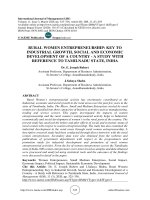Economic growth and economic development 677
Bạn đang xem bản rút gọn của tài liệu. Xem và tải ngay bản đầy đủ của tài liệu tại đây (118.17 KB, 1 trang )
Introduction to Modern Economic Growth
the two factors, we have
µ
d log (MPH /MPL )
σ=−
d log (H/L)
¶−1
The intuition for why, when σ < 1, H-augmenting technical change is L-biased
is simple but important: with gross complementarity (σ < 1), an increase in the
productivity of H increases the demand for labor, L, by more than the demand for
H, in a sense, creating “excess demand” for labor. As a result, the marginal product
of labor increases by more than the marginal product of H. This can be seen most
clearly in the extreme case where σ → 0, so that the two factors become Leontieff.
In this case, starting from a situation in which γAL (t) L (t) = (1 − γ)AH (t) H (t),
a small increase in AH (t) will create an excess of the services of the H factor, and
its price will fall to 0.
15.3. Baseline Model of Directed Technological Change
In this section, we present the baseline model of directed technological change,
which uses the expanding varieties model of endogenous technological change and
the lab equipment specification of the innovation possibilities frontier. The former
choice is motivated by the fact that the expanding varieties model is somewhat
simpler to work with than the model of competitive innovations introduced in the
previous chapter. The lab equipment specification, on the other hand, highlights
that none of the results here depend on technological externalities. Section 15.4
will consider a model of directed technological with change knowledge spillovers.
Exercise 15.19 shows that all of the results presented here generalize to a model of
competitive innovations, thus the assumption of expanding varieties is only adopted
for convenience.
The baseline economy has a constant supply of two factors, L and H, and admits
a representative household with the standard CRRA preferences given by
(15.2)
Z∞
0
C (t)1−θ − 1
dt,
exp (−ρt)
1−θ
663









